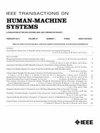Brain-Supervised Conditional Generative Modeling
IF 4.4
3区 计算机科学
Q2 COMPUTER SCIENCE, ARTIFICIAL INTELLIGENCE
引用次数: 0
Abstract
Present machine learning approaches to steer generative models rely on the availability of manual human input. We propose an alternative approach to supervising generative machine learning models by directly detecting task-relevant information from brain responses. That is, requiring humans only to perceive stimulus and react to it naturally. Brain responses of participants (N=30) were recorded via electroencephalography (EEG) while they perceived artificially generated images of faces and were instructed to look for a particular semantic feature, such as “smile” or “young”. A supervised adversarial autoencoder was trained to disentangle semantic image features by using EEG data as a supervision signal. The model was subsequently conditioned to generate images matching users' intentions without additional human input. The approach was evaluated in a validation study comparing brain-conditioned models to manually conditioned and randomly conditioned alternatives. Human assessors scored the saliency of images generated from different models according to the target visual features (e.g., which face image is more “smiling” or more “young”). The results show that brain-supervised models perform comparably to models trained with manually curated labels, without requiring any manual input from humans.脑监督条件生成建模
目前的机器学习方法来引导生成模型依赖于人工输入的可用性。我们提出了一种替代方法,通过直接从大脑反应中检测任务相关信息来监督生成机器学习模型。也就是说,只需要人类感知刺激并自然地做出反应。研究人员通过脑电图(EEG)记录了参与者(N=30)在感知人工生成的人脸图像时的大脑反应,并指示他们寻找特定的语义特征,如“微笑”或“年轻”。利用脑电数据作为监督信号,训练了一个有监督的对抗自编码器来解耦图像的语义特征。该模型随后被调整为生成符合用户意图的图像,而无需额外的人工输入。该方法在一项验证研究中进行了评估,将脑条件模型与手动条件和随机条件的替代方案进行了比较。人类评估人员根据目标视觉特征(例如,哪张脸更“微笑”或更“年轻”)对不同模型生成的图像的显著性进行评分。结果表明,大脑监督模型的表现与人工管理标签训练的模型相当,不需要任何人工输入。
本文章由计算机程序翻译,如有差异,请以英文原文为准。
求助全文
约1分钟内获得全文
求助全文
来源期刊

IEEE Transactions on Human-Machine Systems
COMPUTER SCIENCE, ARTIFICIAL INTELLIGENCE-COMPUTER SCIENCE, CYBERNETICS
CiteScore
7.10
自引率
11.10%
发文量
136
期刊介绍:
The scope of the IEEE Transactions on Human-Machine Systems includes the fields of human machine systems. It covers human systems and human organizational interactions including cognitive ergonomics, system test and evaluation, and human information processing concerns in systems and organizations.
 求助内容:
求助内容: 应助结果提醒方式:
应助结果提醒方式:


